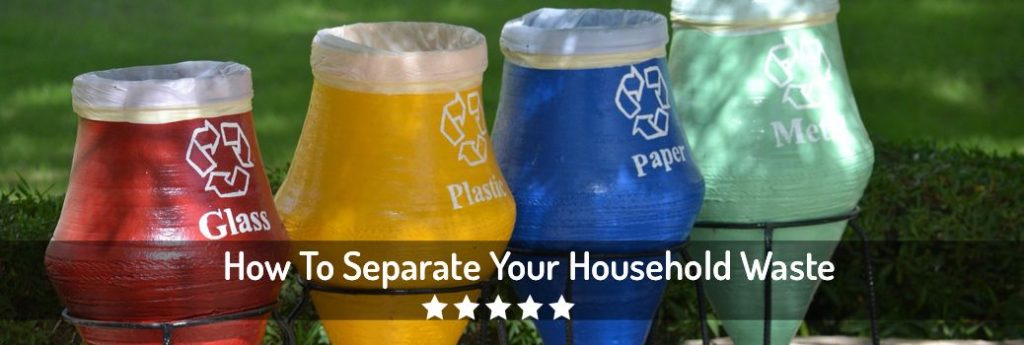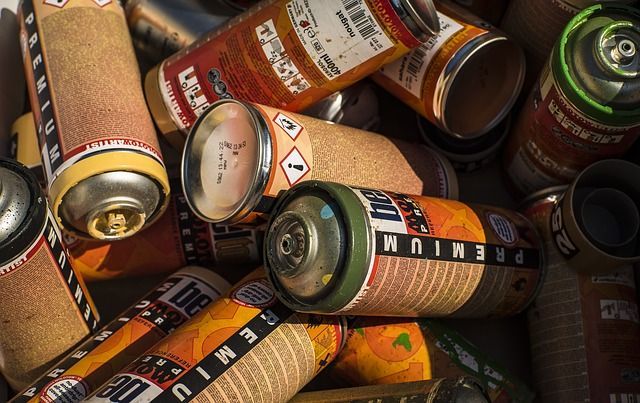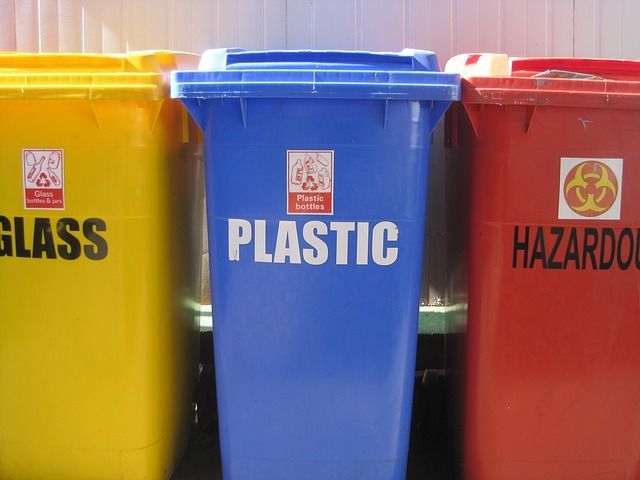
Disposethegarbage.com is supported by our readers. When you buy a product or service through a link on this website, I may earn an affiliate commission.
The typical household experiences different kinds of wastes. To expedite the disposal of these wastes, it is important that they are sorted out and packaged appropriately. This is a task that you can only do if you have the necessary insight to that end. We have decided to come in and offer that very help.
In our discussions here below, we are going to identify the steps you ought to take to make this task a fruitful undertaking. To be guaranteed the best ever outcomes, you have to read through the explanations contained herein thoroughly. Overlooking any provision might have some damning repercussions.
How Can We Separate Waste At Home The Proper Way?
1. Categorize The Wastes Appropriately
Start off by categorizing the wastes appropriately. This simply entails designating the wastes in unique kinds and types. The object of this step is to further help with the convenient disposals of the wastes in the various bags.
This, in turn, promotes smooth handling and transportation of the wastes to the collection centers. Below is a breakdown of the various designations which the household wastes may be subdivided into:
a) Plastic
Anything that is made of plastic falls under this category. Examples of these are plastic bags, bottles, cups, cutlery, toys, and polystyrene food containers. Before the same is placed in the container, they have to be washed and rinsed clean of any debris.
This should follow with drying the same to eliminate any moisture content which might attract flies and mosquitoes.
b) Paper
This refers to any waste that is made of paper. They include such things as magazines, newspapers, drink cartons, manila paper, cardboards, and discarded receipts. Needless to say, you have to read the papers severally to ascertain that you are not throwing anything that is of value. Again, you have to ensure that the paper does not have any moisture embedded in it.
c) Glass and Ceramic Wares
The typical household contains many items that are made of glass and ceramics. You will find these materials adorning the pots, cutlery, and bottles. These are items you have to keep from the reach of children as when they break, they may potentially injure them by way of inflicting cuts. Place them gently in the bins that are designated for them and then cover completely.
- You May Like: Garbage Disposal Vs. Compost Bin
d) Aluminum/Metal
Substances that are made of Aluminum and other metals ought to similarly be separated and placed in distinct places. For one, these materials adorn the utensils, cans, frying pans, woks, spoons, forks, and cooking pots. These wastes are ordinarily too large to be tucked in a compact bin conveniently. That is why you have to look for a larger bin and place them there.
e) Electronics
The typical modern household contains many electronic gadgets. From the light bulbs to cellphones, to computers, to cables, to wires, to calculators, and batteries, the list is virtually endless. These wastes, for the sake of convenient disposal later, have to be sorted out and placed in distinct bins. It is necessary to yet again package these wastes in complete cover and seal them to limit any undue access.
f) Fabrics
Fabrics are by far the single largest wastes in a typical household. You will find them in leather, rubber, shoes, handbags, furniture, T-shirts, bedding, and sneakers, to name but a few! Fabrics are biodegradable, granted.
However, they take too long to break down and may also clog the drains and the household plumbing mechanism. It is important hence to bundle all of them together and keep them safe away.
g) Hazardous Wastes
It is not uncommon to find some hazardous items within a typical household. From the paint cans to the insect repellents to the rat poisons to aerosol cans, these items indeed serve diverse roles.

Owing to their hazardous nature, it is advisable that you exercise greater caution when handling them. On top of segregating them, you have to keep them away from flames and small children.
h) Bulk Items
Bulk items by their nature are too large to handle conveniently. For this reason, you might have to break it into smaller pieces especially if you do not intend to recycle them.
Top examples of them include the large electrical items, bed frames, pieces of furniture and stools. If you wish to resell them, unbolt them and package them.
i) Garden Waste
Do you reside in a self-contained home? If you do, then you will have to contend with the garden wastes from time to time. Chief examples of these are leaves, flowers, foliage, and barks of trees.
It is not advisable to bundle these wastes alongside your normal wastes. That is because such wastes may serve as manure or be used for mulching.
j) Non-recyclables
There are some wastes which you just cannot recycle no matter what. These include some food wastes like the bones, used diapers and tissue papers, laminated wrapping papers, photographic films, and used sanitary pads. For these, you have to place them in their own containers and take them to a collection center to be relayed to a landfill.
k) Animal Wastes
If you keep some pets and animals in your household, they will from time to time urinate and defecate. These wastes are biodegradable and are, as such more convenient to dispose of.
All you have to do is to pick them, place them in a container and then straight away to your garden. If you do not have a garden, package them and take them to a collection center that deals exclusively with them.
2. Maintain Separate Bins
Needless to say, you will have to maintain separate bins for the sake of handling the wastes individually. If possible, you have to color and label each bin uniquely. While at it, be mindful of the requirements of your city as different cities have unique waste labeling codes.

Each bin you label has to be reserved exclusively for each waste you have set it aside for. Some wastes the hazardous types we have looked into above arise too infrequently to warrant a wholesome dedication of the bins. For them, you may have to use the normal bins but switch after disposing of them.
3. Detach The Packaging From The Food Before Disposal
Before placing any waste into the trash bins, it is advisable that you detach the packaging from the food. Food wastes have to be treated as food wastes, the package that contains them has to be treated similarly as such.
Any mix-ups definitely have far-reaching repercussions. In particular, they may interfere with the biodegradability of the wastes altogether.
4. Maintain A Regular Food Disposal Schedule
It is also important that you maintain a regular food disposal schedule. As a general rule, you should store and send the dry wastes out of your home weekly. While at it, you should keep a separate paper bag for storing the used sanitary pads right before storage.
Even if you will not be around your home on the day the municipal truck comes to pick your trash, make appropriate arrangements to have the same picked. Skipping the disposal exercise may cause the wastes to develop some stench and attract flies before the next time the truck comes.
5. Segregate Dry And Wet Wastes
Apart from the various ways and means, we have discussed above, wastes may also be designated as dry or wet. It is important yet again to segregate the wastes further into dry and wet, respectively. That is because the wet wastes are ordinarily more strenuous to handle and engage.
They also bring along the added hassle of attracting germs, encouraging the growth of pathogens and being a hotbed of mosquitoes. If you can dry them, by all means, do so. That way, it will be possible for you to handle them more conveniently not to mention encountering limited hassles.
6. Adhere To The Prevailing Waste Separation And Disposal Standards
Each region, district, and municipality has its own set of rules and regulations that govern the handling and accommodation of waste products. It is absolutely necessary that you take your time to familiarize yourself with these rules and regulations and adhere to them.
The least you might want to happen is to ruffle feathers with the authorities that be. The same applies t any fines, levies, or monies chargeable for handling the wastes altogether. If you are new in the area, you might have to seek the counsel of those who have been there for quite some time.
5 Practical Tips For Better Waste Management At Home
The following practical tips will help you to tackle this chore well. By following them diligently, you will also avoid the likelihood of sustaining diseases which come along with waste handling:
- You should empty your bins regularly. Once a week is not too squeezed or demanding. This is necessary to prevent the emergence of unpleasant smells, the growth of germs, and the attraction of insects.
- Clean the waste bins after each disposal. Be sure to clean both the inside and the outside sections of the bins with clean water and powerful detergents. Dry the bins thoroughly before placing it for use for later waste handling.
- Put on the necessary gears before handing the wastes. Top of these are the aprons, overalls, gloves, gas masks (for handling gaseous wastes), and headgear, to protect from direct contact with the germs and the infections that ordinarily come along.
- Wash your hands thoroughly with medicated soap after handling wastes. Failure to do this might lead to the accumulation of germs on your hands. This is definitely not a good thing to happen as it might predispose you to the risks of hygiene-related infections like cholera, typhoid, and dysentery.
- Keep children away from the waste handling area. Small children are particularly vulnerable to germs and dirty environments. Any exposure of them to these wastes will definitely mean inflicting some diseases on them. This is something that you do not want to happen at all.
Conclusion
Household wastes are very dangerous. They have the ability to cause cholera, dysentery, typhoid, and other hygiene-related ailments. That is why it is imperative that you handle them carefully, timely, and in a diligent way.
Reading through our explanations above severally will definitely give you the insight you need to set out.
As you may already have realized, you need to invest heavily in many pieces of equipment to handle these wastes as need be. The trash bins and the packaging equipment (links go to Amazon) are by far the most significant tools-of-trade you will have to make every effort to acquire.
What more insight may you require from us? Have we not belaboured the points well? Could it be that you are still stuck with regards to how to set out the journey? Kindly let us know on the contact page. We are always eager and on standby to help persons of your kind make the best ever decisions.
Recommended Reading
Do You Need A Dishwasher With A Garbage Disposal?
You are not sure if you need a garbage disposal sytem with a dishwasher? Of course, you badly need a dishwasher with a garbage disposal. Read why...
Learn How To Get Rid Of Kitchen Sink Odor. 14 Easy Ways To Eliminate Stinky Smells.
Is your kitchen sink smelly? Let me show you a couple of easy ways to remove that awful smell from your kitchen using just a few ingredients.
How To Install A Garbage Disposal In 10 Easy Steps. DIY Useful Guide.
After scouring many sources, our team of researchers has come up with perhaps 10 of the most reliable steps to install your garbage disposal.
How To Use A Garbage Disposal Wrench To Unjam Your Device At Home
The garbage disposal wrench is an item you will find to be very handy when your garbage disposal is jammed or you need to unclog it. This is how you do it.
Is Composting Better Than Garbage Disposal? Garbage Disposal Versus Compost Bin.
"Is composting better than garbage disposal?" The straight answer to this question is a firm NO! A garbage disposal is by far the better.
6 Benefits Of Using A Garbage Disposal
Do you have a garbage disposal in your kitchen? Check out the benefits a garbage disposal bring to your kitchen. Life it will be much easier...
